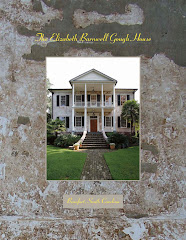.jpg)
Caught in the middle of British and American forces vying for control of Charleston and Savannah, Beaufort suffered more than its share of turbulence and devastation during the Revolution. At one point, from July through September 1779, the British ship Vigilant was anchored in Beaufort Bay with its 24 cannon “ready to defend or destroy the town if necessary.”3 In 1780, Colonel Banastre Tarleton, in one of many troop plunderings, appropriated all of the horses from Beaufort and the Sea Islands as mounts for his “bloody legion.”
In addition to numerous regular troop actions was an almost endless round of raids and reprisals. For many of Beaufort’s families were bitterly divided over the war, with Elizabeth’s own family at the center of one of the bitterest feuds.
Her brothers John, Robert and Edward and the husband of her sister Anne, Gen. Stephen Bull, were all major players in Beaufort on the side of independence. On the side of the British was Elizabeth’s cousin Andrew DeVeaux, who was one of the most vengeful and ruthless in the war. He is said to have used the war as an opportunity to act on his personal hatred of John, Stephen and especially Robert. DeVeaux was responsible for carrying off of hundreds of their slaves and for numerous acts of destruction directed at his cousins personally, including the burning of Sheldon Church (which had been built largely with Bull family money) and Anne and Stephen’s plantation, Laurel Bay.
Even after regular forces had withdrawn from the area, guerrilla raids, murders, reprisals and a climate of lawlessness continued to plague Beaufort until the end of the war. In the chaos, travel and day-to-day commerce came to a virtual halt.The Reverend Archibald Simpson’s description of Beaufort immediately after the war is particularly telling:
“All is desolation…Every field, every plantation…No garden, no enclosure, no mulberry bush, no fruit trees, nothing but wild fennel, bushes, underwood, briars to be seen…a very ruinous habitation…“Every person keeps close to his plantation. Robberies and murders are often committed on public roads. The people that remain are peeled, pillaged and plundered.”4
“An entire generation had grown up between 1775 and 1783, and many knew only the uncertainty, violence and terror of a long war that in Beaufort… took a particularly vengeful turn.”5
In this climate, it is extremely unlikely that Elizabeth would have begun construction on her imposing home. More probably, she began building a new home and a new life for herself and her daughter when Beaufort (and the new country) began rebuilding in the latter half of the 1780s.
3Lawrence S. Rowland, Alexander Moore and George C. Rogers, Jr., The History of Beaufort County, South Carolina, Volume 1, 1514-1861, University of South Carolina Press, Columbia, SC 1996, page 226
4Ibid, page 254
5Ibid, page 255
Please note that the material in this blog is copyrighted. It is not to be reproduced without my specific written permission.
.jpg)
